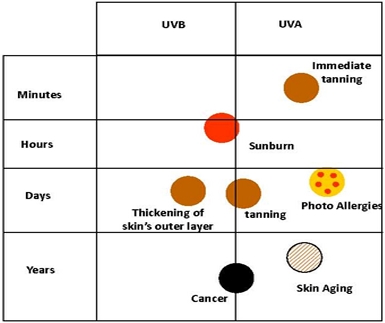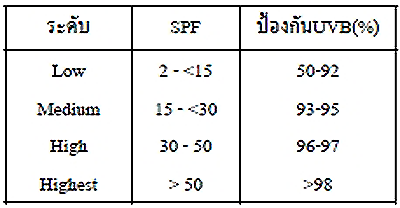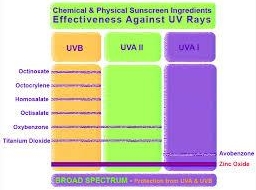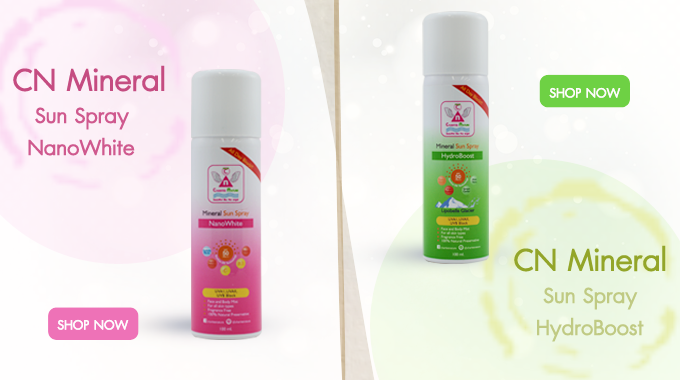What are UV SPF and PA?
Date: 2015-10-01 14:15:35.0
Here's what to know about UV types, SPF and PA. High SPF and PA sunscreens, are they better? What are the benefits of wearing sunscreen?.... Click here!
What are UV SPF and PA?
UV ray, your skin’s enemy

Sunlight is a portion of the electromagnetic radiation, in particular infrared, visible, and ultraviolet light. Ultraviolet light or UV is a cause of our skin damage. UV is classified into four wavelengths.
UVA1,measures 340-400 nanometers, is the large amount of total UV. It penetrates and damages the skin more deeply. It has long been known to play a major part in skin aging, wrinkling, melanoma and skin cancer.
UVA2, measures 340-400 nanometers, is a major cause of uneven skin tone or hyperpigmentation.
UVB, measures 290-320 nanometers, is the chief cause of skin reddening and sunburn. It plays a key role in the development of skin cancer.
UVC ranges from 200-290 nanometers. Most UVC is absorbed by the ozone layer and does not reach the earth.
UVB and UVA2 rays account for 5 and 20 percent of the UV radiation reaching the Earth's surface. The rest, 75 percent of the UV radiation is UVA1. Thus, UVA1 plays a major part in skin aging. Unfortunately, most of sunscreen products could not protect skin from UVA1 effectively. Also, applying sunscreen in the morning is not enough to protect your skin all day. CN Sunscreen Spray provides a solution to sun protection.
Type of UV ray causing skin problems

Since UV ray is harmful to your skin, sunscreen is necessary to protect our skin from UV ray, sunburn, uneven skin tone, aging skin and skin cancer.
The length of time the skin is exposed and UV type

Effect of Sun on Skin – The Ultimate Guide to Sunscreen
Reference :
https://www.youtube.com/watch?v=V46vfg-7dEI&list=PLk9lGsg0I7Lv_MYuFPmKYbf_ueFjvLIyh&index=3
(Youtube : ของ Michelle Phan)
What is SPF?
SPF or Sun protective factor is a measurement sunscreen's effect against UVB rays.
It indicates how long it will take for UVB rays to redden skin when using a sunscreen, compared to how long skin would take to redden without the product.
SPF = taking the time it takes you to burn with a sunscreen and dividing it by the time taken for you to burn without a sunscreen
For example, without using SPF 50 CN Spray Sunscreen (Charites Nature), we burn in 15 minutes. After we spray SPF 50 CN Sunscreen, our skin can be protected 15 * 50 minute = 750 minutes or 12 hours. However, you should reapply it every two hours. This is because sweating, rubbing of clothes and touching our skin will remove the sunscreen. One time applying sunscreen in the morning is not that efficacy to protect your skin from UV. Thus, for the most effectiveness, it is necessary to reapply sunscreen spray that can protect your skin from UVA1,UVA2 and UVB and oxidants every two hours.
Table 2 shows SPF and percentage of UVB protection

What is PA?
PA or Protection grade of UVA refers to the amount of protection the sunscreen offers from the UVA rays, cause of uneven skin tone and wrinkles.
PA+ corresponds to a UVA protection factor between 2-4 times, low protection
PA++ corresponds to a UVA protection factor between 4- 8 times, medium protection
PA+++ corresponds to a UVA protection factor between 8-16 times, high protection
PA++++ corresponds to a UVA protection factor more than 16 times, very high protection
for example, PA++ indicates a UVA protection factor between 4- 8 times
Do a high number SPF and PA mean the best sunscreen products?
Sunscreen SPF 50 PA+++ can effectively protect skin and suits for hot climates such as Thailand. However, higher-number SPFs block slightly more of the sun’s rays. In addition, the higher SPF you use, your pores are likely to clog. No matter how high SPF and PA you use, one time applying sunscreen in the morning is not that efficacy to protect your skin from UV all day. Thus, for the most effectiveness, it is necessary to reapply sunscreen that can protect your skin from UVA1,UVA2 and UVB and oxidants every two hours.
There are two types of sunscreen
- Physical sunscreen can reflect UV and does not cause skin reaction. The mineral using in Physical sunscreen such as titanium dioxide and zinc oxide, can reflect the entire spectrum of UVA UVB rays and infrared. One major drawback of physical sunscreens is that it tends to produce a white cast on the skin and be more greasy. Nowadays, the technology improve sun protection, non greasy and non white cast, which found in CN sunscreen (Charites Nature)
- Chemical Sunscreen works by absorbing the energy of UV rays and converting it to heat that is dispersed in the skin. It contains Avobenzone, the derivative of Dibenzoylmethane. It can absorb full spectrum UVA rays. Chemical sunscreen benefits are non greasy and non white cast on the skin, which found in CN sunscreen (Charites Nature)

What are advantages in sunscreen
- Prevent burn and skin reaction from sun
- Prevent aging skin
- Prevent skin discolorations and facial brown spots
- Protect damaged skin from the sun
- Decrease the development of skin cancer
Using sunscreen with whitening cream help to brighten your skin. Using sunscreen with moisturizer help to soften your skin, boost skin hydration, and reduce wrinkles from dehydrated skin and skin eczema.
Reference
1) Wilkinson, J.B. ; Moore, R.J: 7th edition 1982. Sunscreen, Suntan and Anti-sunburn Preparations. Harry's Cosmeticology : George Godwin London. p. 222-242.
2) Johnson, B.E. Changes in sunburn and mechanism of protection. Journal of Society of Cosmetic Chemists of Japan 978, 29 : 32-44
3) Balsam, M.S ; Sagarin Edward 2th edition 1927. Suntan Preparations Kreps Saual I ; Goldemberg Robert L. Cosmetics Science and Technology : United States of America. p. 254-256
4) ข่าวกรมวิทยาศาสตร์การแพทย์ ปีที่ 1 ฉบับที่ 2 รังสี ultraviolet กับมะเร็งผิวหนัง Chemical & Engineering news, Novenber 24, 1986.
5) Fitzpatrick TB ; Pathak Ma and Parrish J.A. Protection of the human skin against the effects of the sunburn UV (290-320 nm) In : Sunlight and man. Normal and abnormal photobiologic response. Pathak MA. Harber LC, Seije N et al (eds). University of Tokyo Press, Tokyo. 1970:751.
6) Blum, H.F. and Kirby Smith, J.S., Science, 1942, 96, 203.
7) Parrish JA ; White MB and Pathak MA, Photomedicine In : Dermatology in General Medicine. Fitzpatrick TB, Eisen AZ, Woff K, Freedberg IM, Austen KF. (2nd ed.), 1979 : 984.
8) Nater, J.P. ; De Groot A.C. 1983 Sun and Solaria Cosmetics. Unwanted Effects of Cosmetics and Drugs Used in Dermatology.
9) สุวรรณประกร พิชิต พิมพ์ครั้งที่ 1 พ.ศ. 2528. Depigmenting agents & Sunscreens. ตำรายาและวิธีการรักษาโรคผิวหนัง : บริษัท โพสต์ พับลิชชิง จำกัด กรุงเทพมหานคร หน้า 195-202.
10) Shaath, Nadim A. Edcyclopedia of UV Absorbers for Sunscreen Products. Cosmetics & Toiletries 1987, 102 : 21-36.
11) แนวทางในการใช้ Sunscreen. Clinical Practice Guideline for Sunscreen. นายแพทย์นภดล นพคุณ.
12) http://www.thaicosmetic.org
CN works with doctors pharmacists and skincare experts to invent new innovative sunscreen. With the latest technology, it provides superior broad- spectrum, UVA1, UVA2 and UVB, protection during the day. This sunscreen product suits women who wear makeup everyday. This is a reason that woman couldn’t reapply sunscreen during a day. With the superior effectiveness and technology, CN provides a solution which couldn’t find it in the traditional sunscreens.






